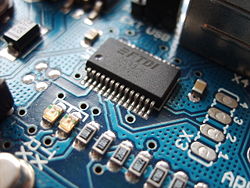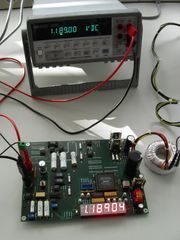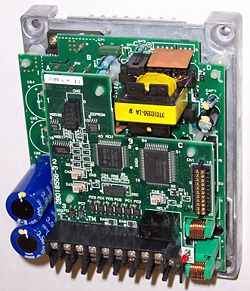Electronics
2008/9 Schools Wikipedia Selection. Related subjects: Engineering
Electronics is the study of the flow of charge through various materials and devices such as semiconductors, resistors, inductors, capacitors, nano-structures and vacuum tubes. Although considered to be a theoretical branch of physics, the design and construction of electronic circuits to solve practical problems is an essential technique in the fields of electronic engineering and computer engineering. This science starts about 1908 with the invention by Dr Lee De Forest of the valve (triode) Before 1950 this science was named "Radio" or "Radio technics" because that was its principal application.
The study of new semiconductor devices and surrounding technology is sometimes considered a branch of physics. This article focuses on engineering aspects of electronics.
Overview of electronic systems and circuits
Electronic systems are used to perform a wide variety of tasks. The main uses of electronic circuits are:
- The controlling and processing of data.
- The conversion to/from and distribution of electric power.
Both these applications involve the creation and/or detection of electromagnetic fields and electric currents. While electrical energy had been used for some time prior to the late 19th century to transmit data over telegraph and telephone lines, development in electronics grew exponentially after the advent of radio.
One way of looking at an electronic system is to divide it into 3 parts:
- Inputs – Electronic or mechanical sensors (or transducers). These devices take signals/information from external sources in the physical world (such as antennas or technology networks) and convert those signals/information into current/ voltage or digital (high/low) signals within the system.
- Signal processors – These circuits serve to manipulate, interpret and transform inputted signals in order to make them useful for a desired application. Recently, complex signal processing has been accomplished with the use of Digital Signal Processors.
- Outputs – Actuators or other devices (such as transducers) that transform current/voltage signals back into useful physical form (e.g., by accomplishing a physical task such as rotating an electric motor).
For example, a television set contains these 3 parts. The television's input transforms a broadcast signal (received by an antenna or fed in through a cable) into a current/voltage signal that can be used by the device. Signal processing circuits inside the television extract information from this signal that dictates brightness, colour and sound level. Output devices then convert this information back into physical form. A cathode ray tube transforms electronic signals into a visible image on the screen. Magnet-driven speakers convert signals into audible sound.
Electronic devices and components
An electronic component is any physical entity in an electronic system whose intention is to affect the electrons or their associated fields in a desired manner consistent with the intended function of the electronic system. Components are generally intended to be in mutual electromechanical contact, usually by being soldered to a printed circuit board (PCB), to create an electronic circuit with a particular function (for example an amplifier, radio receiver, or oscillator). Components may be packaged singly or in more or less complex groups as integrated circuits.
Types of circuits
Analog circuits
Most analog electronic appliances, such as radio receivers, are constructed from combinations of a few types of basic circuits. Analog circuits use a continuous range of voltage as opposed to discrete levels as in digital circuits. The number of different analog circuits so far devised is huge, especially because a 'circuit' can be defined as anything from a single component, to systems containing thousands of components.
Analog circuits are sometimes called linear circuits although many non-linear effects are used in analog circuits such as mixers, modulators, etc. Good examples of analog circuits include vacuum tube and transistor amplifiers, operational amplifiers and oscillators.
Some analog circuitry these days may use digital or even microprocessor techniques to improve upon the basic performance of the circuit. This type of circuit is usually called "mixed signal."
Sometimes it may be difficult to differentiate between analog and digital circuits as they have elements of both linear and non-linear operation. An example is the comparator which takes in a continuous range of voltage but puts out only one of two levels as in a digital circuit. Similarly, an overdriven transistor amplifier can take on the characteristics of a controlled switch having essentially two levels of output.
Digital circuits
Digital circuits are electric circuits based on a number of discrete voltage levels. Digital circuits are the most common physical representation of Boolean algebra and are the basis of all digital computers. To most engineers, the terms "digital circuit", "digital system" and "logic" are interchangeable in the context of digital circuits. In most cases the number of different states of a node is two, represented by two voltage levels labeled "Low"(0) and "High"(1). Often "Low" will be near zero volts and "High" will be at a higher level depending on the supply voltage in use.
Computers, electronic clocks, and programmable logic controllers (used to control industrial processes) are constructed of digital circuits. Digital Signal Processors are another example.
Building-blocks:
- Logic gates
- Adders
- Binary Multipliers
- Flip-Flops
- Counters
- Registers
- Multiplexers
- Schmitt triggers
Highly integrated devices:
- Microprocessors
- Microcontrollers
- Application-specific integrated circuit(ASIC)
- Digital signal processor (DSP)
- Field-programmable gate array (FPGA)
Mixed-signal circuits
Mixed-signal circuits refers to integrated circuits (ICs) which have both analog circuits and digital circuits combined on a single semiconductor die or on the same circuit board. Mixed-signal circuits are becoming increasingly common. Mixed circuits are usually used to control an analog device using digital logic, for example the speed of a motor. Analog to digital converters and digital to analog converters are the primary examples. Other examples are transmission gates and buffers.
Heat dissipation and thermal management
Heat generated by electronic circuitry must be dissipated to prevent immediate failure and improve long term reliability. Techniques for heat dissipation can include heatsinks and fans for air cooling, and other forms of computer cooling such as water cooling. These techniques use convection, conduction, & radiation of heat energy.
Noise
Noise is associated with all electronic circuits. Noise is defined as unwanted disturbances superposed on a useful signal that tend to obscure its information content. Noise is not the same as signal distortion caused by a circuit.
Electronics theory
Mathematical methods are integral to the study of electronics. To become proficient in electronics it is also necessary to become proficient in the mathematics of circuit analysis.
Circuit analysis is the study of methods of solving generally linear systems for unknown variables such as the voltage at a certain node or the current though a certain branch of a network. A common analytical tool for this is the SPICE circuit simulator.
Also important to electronics is the study and understanding of electromagnetic field theory.
Electronic test equipment
Electronic test equipment is used to create stimulus signals and capture responses from electronic Devices Under Test (DUTs). In this way, the proper operation of the DUT can be proven or faults in the device can be traced and repaired.
Practical electronics engineering and assembly requires the use of many different kinds of electronic test equipment ranging from the very simple and inexpensive (such as a test light consisting of just a light bulb and a test lead) to extremely complex and sophisticated such as Automatic Test Equipment.
Computer aided design (CAD)
Today's electronics engineers have the ability to design circuits using premanufactured building blocks such as power supplies, semiconductors (such as transistors), and integrated circuits. Electronic design automation software programs include schematic capture programs and printed circuit board design programs. Popular names in the EDA software world are NI Multisim, Cadence ( ORCAD), Eagle PCB and Schematic, Mentor (PADS PCB and LOGIC Schematic), Altium (Protel), LabCentre Electronics (Proteus) and many others.
Construction methods
Many different methods of connecting components have been used over the years. For instance, early electronics often used point to point wiring with components attached to wooden breadboards to construct circuits. Cordwood construction and wire wraps were other methods used. Most modern day electronics now use printed circuit boards (made of FR4), and highly integrated circuits. Health and environmental concerns associated with electronics assembly have gained increased attention in recent years, especially for products destined to the European Union, with its Restriction of Hazardous Substances Directive (RoHS) and Waste Electrical and Electronic Equipment Directive (WEEE), which went into force in July 2006.
Electronics industry
- Semiconductor sales leaders by year
Branch pages
- Digital electronics
- Analogue electronics
- Microelectronics
- Fuzzy electronics
- Circuit Design
- Integrated circuit
- Optoelectronics
- Semiconductor
- Semiconductor device


